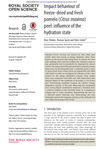Please use this identifier to cite or link to this item:
http://lib.hpu.edu.vn/handle/123456789/22307Full metadata record
| DC Field | Value | Language |
|---|---|---|
| dc.contributor.author | Thielen, Marc | en_US |
| dc.contributor.author | Speck, Thomas | en_US |
| dc.contributor.author | Seidel, Robin | en_US |
| dc.date.accessioned | 2016-07-18T06:49:13Z | |
| dc.date.available | 2016-07-18T06:49:13Z | |
| dc.date.issued | 2015 | en_US |
| dc.identifier.other | HPU4160461 | en_US |
| dc.identifier.uri | https://lib.hpu.edu.vn/handle/123456789/22307 | - |
| dc.description.abstract | Pomelos (Citrus maxima) are known for their thick peel which—inter alia—serves as energy dissipator when fruits impact on the ground after being shed. It protects the fruit from splitting open and thus enables the contained seeds to stay germinable and to potentially be dispersed by animal vectors. The main part of the peel consists of a parenchymatous tissue that can be interpreted from a materials point of view as open pored foam whose struts are pressurized and filled with liquid. | en_US |
| dc.format.extent | 12 p. | en_US |
| dc.format.mimetype | application/pdf | - |
| dc.language.iso | en | en_US |
| dc.subject | Structural biology and biophysics | en_US |
| dc.subject | Biomechanics | en_US |
| dc.subject | Citrus maxima | en_US |
| dc.subject | Cellular material | en_US |
| dc.subject | Energy dissipation | en_US |
| dc.subject | Coefficient of restitution | en_US |
| dc.subject | Maxwell model | en_US |
| dc.title | Impact behaviour of freeze-dried and fresh pomelo peel | en_US |
| dc.type | Article | en_US |
| dc.size | 1.26MB | en_US |
| dc.department | Education | en_US |
| Appears in Collections: | Education | |
Files in This Item:
| File | Description | Size | Format | |
|---|---|---|---|---|
| 0344_Impactbehaviour.pdf Restricted Access | 1.29 MB | Adobe PDF |  View/Open Request a copy |
Items in DSpace are protected by copyright, with all rights reserved, unless otherwise indicated.
